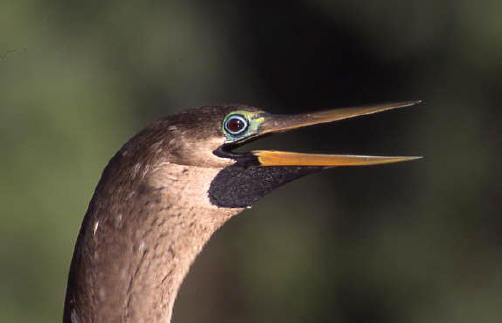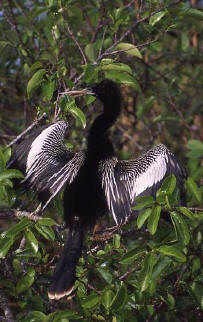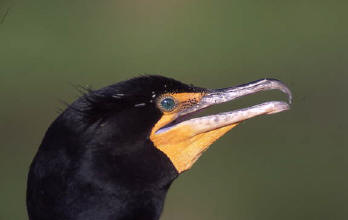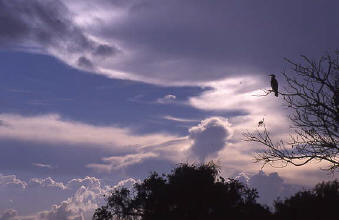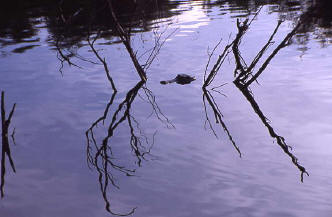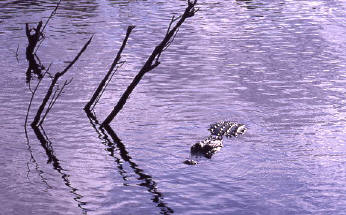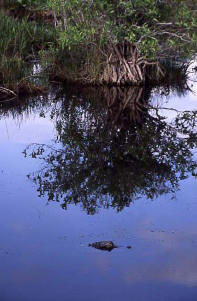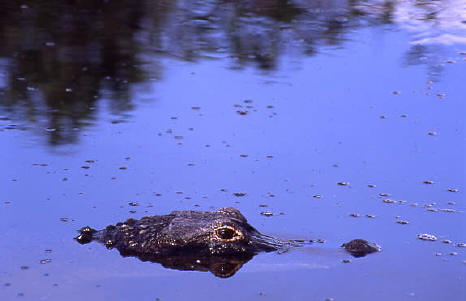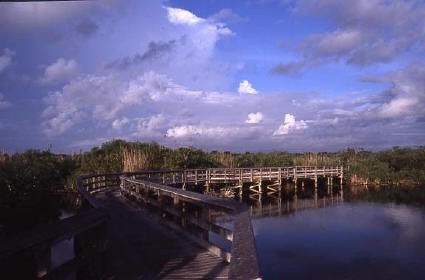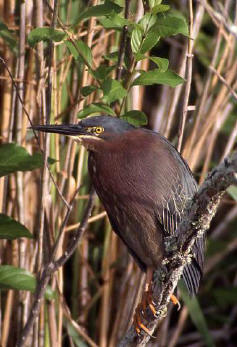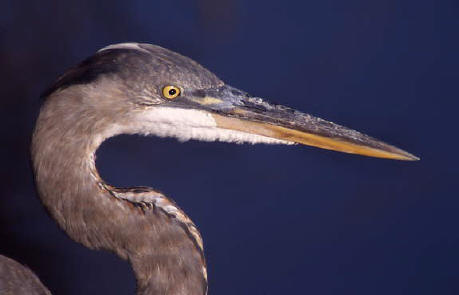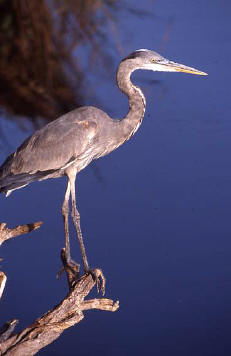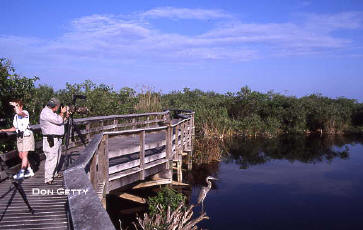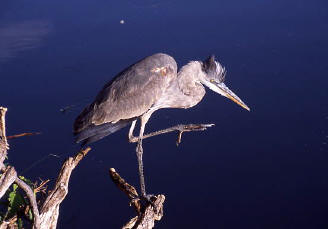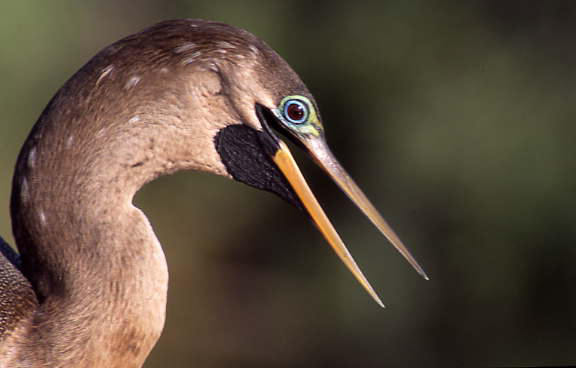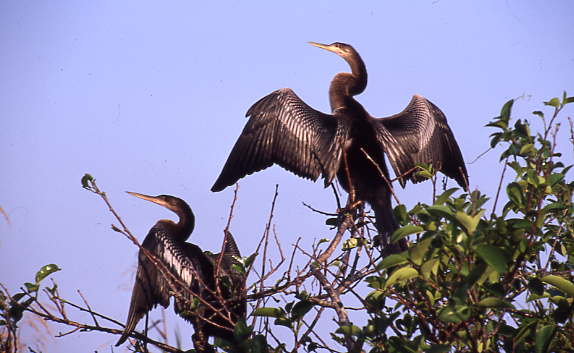|
Anhingas , Alligators & Abstracts Life in The Everglades by Jim Moerschel It's 6:30 a.m., and the first, soft rays of light begin to play upon the seemingly endless saw grass and I'm about to enter one of the everglades best "hot spots" for bird photography, The Anhinga Trail. This trail is only a couple of miles from the visitor center and is easy to find and also easy to walk. The trail, which is paved near the entrance and then becomes a flat boardwalk, loops around the pond and through the amber saw grass, a distance of about a half mile. This is a favorite wintering spot for several species of birds, alligators, turtles, snakes and lots of fish and at daybreak, all of these creatures are out hunting. There are others out hunting too. Ahead of me are two other people and another couple right behind. Each of us walks slowly, speaking in hushed tones if at all and each is burdened with the same apparatus - a tripod, camera and a very long lens. This time of day belongs to the Nature Photographer.
Vultures and Cormorants are the first birds that greet us this morning. The photography begins right at the beginning of the trail where I make a few silhouette images of the vultures congregating in a nearby tree. Just ahead, sitting quietly on the stone wall are several cormorants that will allow a very close approach if I take my time and move in slowly. These birds, like many others here, are habituated to the people who come to this trail each day, so they tolerate a long lens poking at them from just a few feet away. Far down the trail where the boardwalk curves over the pond, I see several alligators floating, half submerged amongst some tree branches sticking up through the surface. At this time of day, the sun is backlighting my view of both the gators and the branches and I realize right off that I have the opportunity to create some neat abstracts. My 100 - 300 zoom is the right lens for this type of work, since I'm going to be changing focal lengths rapidly as I search for the nicest compositions. Some, I shoot at 300mm, others at 100mm and several in between. These highly backlit images take on the look of black and white photos although I'm using color slide film. Abstracts in nature are pure fun and by moving back and forth, left and right I can change the entire "look" to the final image. Just using a gator and some dead branches.
At one end of the pond I see what appears to be a small stump sticking up through the water. A closer inspection through my long lens reveals an alligator head. I'm still using my 100 - 300 zoom and I decide to create a scene that will show a mangrove in the background. In order to include the gator, I must rotate the lens to the vertical format. Now my composition tells a story. The gator is placed in the bottom portion of the frame and the mangrove thicket with reflection fills the remainder of the image. Next, I zoom in on the alligator, rotate the lens to a horizontal position and create a second image. I do this selective process quite a lot. Many times there will be a completely new image to be had from the first one. In other words, "finding the photo within the photo."
By now the sun is up and beaming brightly into the thickets, mangroves and saw grass. By looking very closely into the tangle of reeds, I spot a Little Green Heron. The bird blends right in with the surroundings and is at quite a distance. Now I put my 400mm lens on and also place my Nikon flash on the camera hotshoe . I use another device called the flash extender, which is a very lightweight mount that holds a plastic magnifying type lens right in front of the flash. This narrows down the beam of light, projecting it further toward the subject allowing the photographer to gain a slight fstop advantage and to give that all important "highlight" to the eye.
To capture the Little Green Heron, required a 1.5 tele-extender to be mounted along with my 4oomm. The bird was on the opposite side of the narrow canal and at too great a distance for good image size for the 400 to do the job. Now I had 600 to work with and the composition became much stronger. The morning light beamed right in on the bird and I shut off my flash unit. With vertical reeds surrounding the heron and the fact the bird was perched upright, I rotated the lens to the vertical format, placed the heron just slightly off center and waited for the bird to twist its head sideways for a nice pose. This scene contains enough medium tones throughout that I left the metering system on Matrix. I took a few photos, then turned the exposure compensation dial one notch and took a few more. I've owned this camera for several years now, and know how the meter reacts to various types of light. I felt very confident after shooting 6 frames and using the compensation dial for just a bit more saturation.
Just up ahead, a Great Blue Heron was perched on an old stump. It stood like a statue, bathed in that wonderful, sweet light of early morning. No need for flash here either. I set my tripod right next to another fellow photographer, who I had met the past few mornings on this trail and we both settled in with our "big guns" aimed at this regal bird. Nature photography demands lots of patience and bird photography takes that to the extreme. The man standing next to me is Don Getty, who is quickly becoming one of the premier wildlife photographers in the country. His work is already on this website and hopefully more to come. Don and I stood for quite some time waiting, eyes straining, keeping aware for something to happen. Without a warning, the bird became animated, raising one leg straight out, then scratching its head with the foot, bobbing its head up and down and performing as if on cue. Needless to say, Don and I fired away in unison. The results of patiently waiting for the action to begin shows bird behavior, not just a rigid bird statue.
Several of the birds allowed me to approach very close and with a 400mm lens it was not too difficult to get great image size of just the head. Once again, I waited for some animation with an Anhinga. I had several head shots "in the bank," but I was hoping for an open beak shot. After waiting long enough, it happened. Many of the birds along the anhinga trail allowed for nice portraits to be made.
Now it was around 9:30a.m. The sun was getting higher - the "sweet light" was gone. Many of the birds had flown off into more secluded areas leaving a remnant force behind. Now, many more people walked onto the boardwalk, none had tripods or cameras with very long lenses. They had eaten breakfast, taken their time and were here to see the birds. As they were walking in, the tripod crew was packing it in. The "sweet light" was over, the dramatic shadows were gone and dynamic images would be very rare. Now it was time for a leisurely breakfast. The Anhinga Trail now belonged to the tourist crowd. I wish you
good luck in your image making and may all your visions be photogenic."
|
